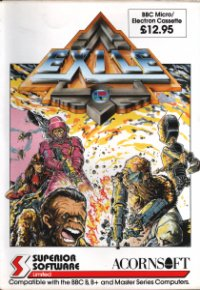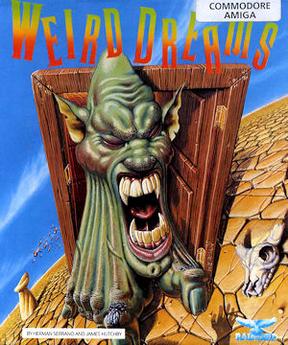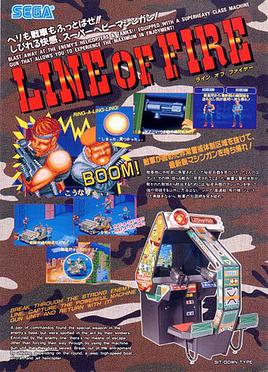
Wonder Boy in Monster Land, known by its original arcade release as Wonder Boy: Monster Land, is a platform video game developed by Westone Bit Entertainment and released by Sega in Japanese arcades in 1987 and for the Master System in 1988, with a number of other home computer and console ports following. The game is the sequel to the 1986 game Wonder Boy and takes place eleven years after the events in the previous game. After enjoying over a decade of peace on Wonder Land following the defeat of the evil King by Tom-Tom, later bestowed the title "Wonder Boy", a fire-breathing dragon called the MEKA dragon appeared; he and his minions conquered Wonder Land, turning it into "Monster Land". The people, helpless due to their lack of fighting skill, call for Wonder Boy, now a teenager, to destroy the monsters and defeat the MEKA dragon. Players control Wonder Boy through twelve linear levels as he makes his way through Monster Land to find and defeat the MEKA dragon. Players earn gold by defeating enemies and buy weapons, armor, footwear, magic, and other items to help along the way.

Llamatron is a multidirectional shooter video game programmed by Jeff Minter of Llamasoft and released in 1991 for the Atari ST and Amiga and in 1992 for MS-DOS. Based on Robotron: 2084, players of Llamatron control the eponymous creature in an attempt to stop an alien invasion of Earth and rescue animals—referred to as "Beasties"—for points. Players advance by destroying all of the enemies on each level using a laser that fires automatically in the direction that the Llamatron is moving. Various power-ups exist to aid the player in defeating the wide variety of enemies and obstacles they face along the way.

Exile is a single-player action-adventure video game originally published for the BBC Micro and Acorn Electron in 1988 by Superior Software and later ported to the Commodore 64, Amiga, CD32 and Atari ST, all published by Audiogenic. The game was designed and programmed by Peter Irvin and Jeremy Smith. It is often cited as one of the earliest examples of a Metroidvania game and featured "realistic gravity, inertia and object mass years before players understood the concept of a physics engine... an astounding level of AI, stealth-based gameplay, a logical ecosystem governing the world's creatures and a teleportation mechanic that feels startlingly like a predecessor to Portal".

Abuse is a run and gun video game developed by Crack dot Com and published by Electronic Arts in North America and Origin Systems in Europe. It was released on February 29, 1996 for MS-DOS. A Mac OS port of the game was published by Bungie and released on March 5, 1997. The game's source code, along with some of the shareware content, has been in the public domain since the late 1990s and has been ported to Linux and many other platforms.

Star Goose is a vertically scrolling shooter that was published for the Amiga, Atari ST, and MS-DOS by Logotron in 1988. The player controls Scouser-Gitt, who pilots the eponymous Star Goose, a vessel that has been commissioned to scour the planet Nom and collect 48 crystals. Players must collect all six crystals in each of the game's eight levels to advance, while at the same time avoiding or destroying enemies and maintaining their shield, ammunition, and fuel levels. The game's surfaces are contoured, which affects the way that bullets travel, and contain tunnels that switch modes to a three-dimensional perspective where the player can replenish their resources.

Xenon 2: Megablast is a 1989 shoot 'em up video game developed by The Bitmap Brothers and published by Image Works for the Amiga and Atari ST. It was later converted to the Master System, PC-98, X68000, Mega Drive, Commodore CDTV, Game Boy, Acorn Archimedes and Atari Jaguar platforms. The game is a sequel to Xenon and takes place a millennium after the previous title. The goal of the game is to destroy a series of bombs planted throughout history by the Xenites, the vengeful antagonists of the first game.

North & South is a strategy action game released in 1989 for the Amiga, and Atari ST and ported to the Nintendo Entertainment System, Amstrad CPC, MSX, MS-DOS, Commodore 64 and ZX Spectrum. It was developed and published by Infogrames.

Fire Power is a military tank action game developed by Silent Software for the Amiga. It was released in 1987 and published by MicroIllusions and Activision. Ports were released for the Apple IIGS, the Commodore 64 and for MS-DOS in 1988. An Atari Lynx version was planned but development never started due to internal conflict with Epyx.

Shadow Dancer is a side-scrolling hack-and-slash action game produced by Sega and originally released as an arcade game in 1989. It is the second and the final arcade game in the Shinobi series, following the original Shinobi itself. The player controls a ninja aided by an attack dog, who is fighting to save the city from a terrorist organization.

Forgotten Worlds, originally titled Lost Worlds, is a side-scrolling shooter video game by Capcom, originally released as a coin-operated arcade game in 1988. It is notable for being the first title released by Capcom for their CP System arcade game hardware.

B-Wings is a vertically scrolling shooter first released as an arcade video game by Data East in 1984. A version was released in 1986 for the Family Computer. It was Data East's first home release for the console. The Family Computer version is notable for its inclusion in many unofficial Famiclone multicarts.

Battle Squadron is a vertically scrolling shooter for the Amiga for one or two players. It is a sequel to Hybris. A version for the Mega Drive was released in 1990. The game was later ported to iOS devices (2011), Android (2012) and in 2013 also to AmigaOS 4, Windows, OS X and MorphOS.

F/A-18 Interceptor is a combat flight simulator developed by Intellisoft and published by Electronic Arts for the Amiga in 1988. The player mainly flies the F/A-18 Hornet, but the F-16 Fighting Falcon is also available for aerobatics, free flight and the first mission. Contrary to the title of the game, the real F/A-18 is not a true interceptor aircraft, having been designed instead as a multirole anti-ship strike fighter.

Gunhed, known as Blazing Lazers in North America, is a vertically scrolling shooter game by Hudson Soft and Compile, based on the Japanese film Gunhed. The title was released in 1989, for the PC Engine in Japan and re-skinned for the TurboGrafx-16 in North America, with Gunhed unofficially imported for the PC Engine in Europe. In the game, a fictional galaxy is under attack by an enemy space armada called the Dark Squadron, and this galaxy's only chance for survival is the Gunhed Advanced Star Fighter, who must destroy the Dark Squadron and its Super Weapons. The gameplay features fast vertical scrolling and a wide array of weapons for the player to use.

Predator is a 1987 side-scrolling action game based on the 1987 film Predator, and the first game based on the franchise.

SWIV is a vertically scrolling shooter released in 1991 for the Amiga, Atari ST, Commodore 64, MSX, ZX Spectrum, and Amstrad CPC computers. A Game Boy Color conversion was published in 2001.

Weird Dreams is a cinematic platform game developed by Rainbird Software which was published for the Amiga, Atari ST, Commodore 64, and DOS. A modified version served as the visual component to a phone-in quiz on ITV's Motormouth. The game was planned for release on Amstrad CPC and ZX Spectrum, but both versions were cancelled.

Armalyte is a left-to-right scrolling shooter in the style of Gradius released for the Commodore 64 by Thalamus Ltd. It was marketed by Thalamus as the sequel to Delta, which was also a left-to-right horizontally scrolling shoot 'em up, but Delta was created by a different programming team.

Line of Fire / Line of Fire: Bakudan Yarou is a first-person light gun shooter game developed by Sega and released for arcades in 1989. It was released with two arcade cabinet versions, a standard upright and a sit-down cockpit, both featuring two positional guns. The cockpit design allows the player(s) to sit down while playing the game, while having two-handed machine guns, controlled by a potentiometer-controlled gun alignment software system. The game follows a two-man commando unit as they try to escape from a terrorist facility after seizing a prototype weapon.
Cope-Com is a Danish Amiga software developer founded in 1987 by Martin B. Pedersen and Torben B. Larsen.


















